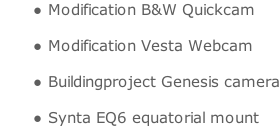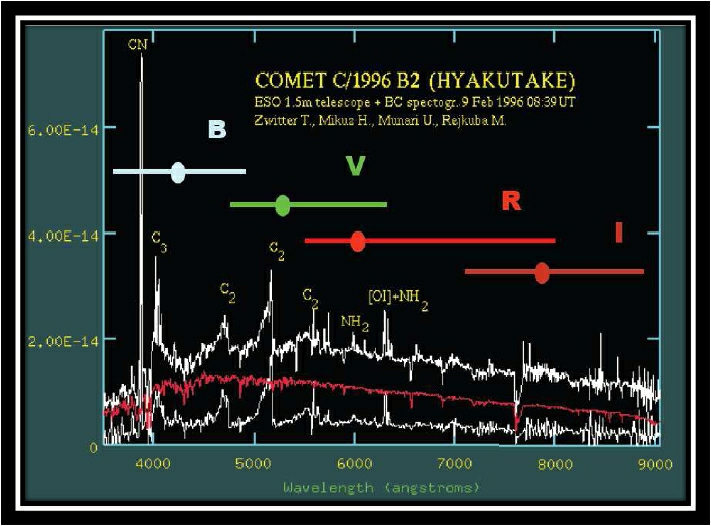



Copyright © All rights reserved. Made By Erik Bryssinck Terms of use | Privacy policy














Optical filters for Afρ-
Why using filters for observing comets ?
As we all know, use of filters is a decreasing of light that is falling to our CCD-
BUT !! From our experience unfiltered data can be also sometimes useful but it isn’t enough for a complete scientific approach and for a systematic monitoring of comets. Most unfiltered data (except for astrometry) are unlukily useless for science.
For this reason the use of standard filters is encouraged in order to provide at least images giving information about a well defined and not too large, spectral range. This increases the scientific meaning of our results and allows a better general calibration of the data. Furthermore our observations will be more easily compared with the ones performed by professional astronomers that use the same standard filter sets (or other standards close to ours (CARA)).
To purchase a single filter is not so expensive and nowadays there are some affordable solutions. It is a matter of fact that (nowadays) a photometric filter is less or as expensive than an average quality eyepiece!
The choice depends mainly on the spectral sensitivity of your CCD; of course we suggest to buy a filter close to the peak response of the chip. Most observers use an R band filter (Cousins or Bessel standards), but pay attention to purchase a photometric filter and not an RGB series filter, or other kind of “red” filters made for other purposes. Some “red” RGB filters can be also useful but a check of the transmission curve is necessary.
Also, take into account that a standard photometric filter can be useful also for other kind of observations, as variable stars and minor planets. It is a quite useful tool if you have in mind to make a little of science with your telescope !
The spectrum of a comet usually shows two distinct components: a continuum part due to the sunlight scattered and reflected by dust grains and a superimposed emission spectrum due to the coma and tail gas components. As you see below, a example of a spectrum of comet Hyukutake:

here you can see what type of filter 5 photometric filters (BVRI filters are displayed) which gas tail components still let in a lower amount. We mostly use always the R or the I-
Specific filters are needed to obtain quantitative data on the different components.
Best results are obtained with narrowband filters centered at specific wavelengths and for this purpose specific standard sets have been defined (IHW set, Hale Bopp set).
Unluckily these filter are expensive and not easily available. An alternative was found among cheaper commercial filters where some have characteristics very close to the professional standards. The first tests on these filters have been done at the Crni Vrh Observatory, especially for tail imaging; dust and H2O+ components.
The dust continuum one, proved good also for coma photometry and Afρ quantity measurements on bright comets.
The photometric calibration of the 647 nm filter is made by approximating its pass band to the one of the S Vilnius photometric band, centered on the hydrogen line and very close to our filter.
The uncertainty introduced by this approximation does not exceed 1-
|
component |
Type |
Central wavelength (Angstrom) |
Bandwidth Angstrom |
|
continuum |
Dust |
3650 |
80 |
|
CN |
Gas (coma) |
3870 |
62 |
|
C3 |
Gas (coma) |
4062 |
62 |
|
CO+ / N2+ |
Gas (tail) |
4266 |
64 |
|
continuum |
dust |
4860 |
85 |
|
C2 |
Gas (tail) |
5114 |
80 |
|
H2O+ |
Gas (tail) |
7000 |
175 |
|
continuum |
Gas (coma) |
7195 |
150 |
Standard IHW filters (International Hally Watch)
|
component |
Type |
Central wavelength in nm |
Bandwidth nm |
Catalog code Edmund Optics |
|
C3 |
Gas (Coma) |
405 |
10 |
43104 |
|
continuum |
Dust |
486 |
10 |
46040 |
|
C2 |
Gas (coma) |
515 |
10 |
43120 |
|
Na |
Gas (coma- |
589 |
10 |
43129 |
|
H2O+ |
Gas (tail) |
620 |
10 |
43132 |
|
continuum |
dust |
647 |
10 |
43136 |
Alternative narrowband filters from Edmund Optics
Wide band filters were born for stellar studies and were not planned for observing comets. But some of them can be used for a general work, especially on distant or faint comet, as well with objects that display a very strong dust component.
The advantage is to work in a well defined spectral range and that a number of reliable reference stars are commonly available. Among the many photometric systems adopted by professional astronomers one widely used is the Johnson-
Filters sets useful for CCDs have been reviewed in detail by Bessel (PASP, 1990, vol. 102, p.1181).
Other very usefull paper: The HB Narrowband Comet Filters: Standard Stars and Calibrations ( Tony L. Farnham1 and David G. Schleicher and M.A. Hearn )
Take into account that with wide band filters the effective photometric band is defined by the filter, the CCD spectral sensitivity and the telescope characteristics (spectral reflectance or transmission) and sky condition.
It is a matter of fact that the (our) system will be close to the standard photometric band but will not match it exactly.
At our level of accuracy and using stars with nearly the same color of the Sun, this do not introduces relevant errors. On the other hand the narrow-
The R and I pass-
An example is 153P/Ikeya-
647 nm filter (10 nm FWHM) Afρ = 5330 ± 180
I (Cousins) filter Afρ = 8600 ± 250
V (Johnson) filter Afρ = 12880 ± 400
We can see that the I band value is approximately 60% higher than the red continuum 647 nm filter one. Taking into account the reddening of the light in different pass-
As a reference the V band Afρ value have also been reported. As discussed above he V band is usually strongly contaminated by the C2 gas emission bands, and the very high unrealistic value found in this comet clearly shows this fact.
It is evident that for active comets the assumption that R and I bands contain negligible gas contaminations is not always true and we must be very careful in adopting default assumptions while analyzing the data. Must be taken also into account that the characteristics of our comet can change with time, heliocentric distance and if unusual temporary events occurs. Where possible a cross check against the 647 nm filter is always recommended for active comets.
Suggested narrowband filters for non professional astronomers
Commercial narrowband filters useful for cometary observing selected among the ones available from worldwide manufacturers (e.g. Edmund Optics, Andover Corporation). These filters are a bit more expensive than classic photometric filters and have a limited lifetime. After 5-
The FWHM (Full Width Half Maximum) of the filters is 10 nm and the peak transmission indicatively close to 50% or so (it can slightly vary depending on the filter type, on its age and also on the spectral range). The pass-
C3 (coma) -
Blue (continuum) -
C2 (coma) -
Red (continuum) -
H2O+ (tail) -
Na (coma and tail) -
Except the 647 nm filter, that as mentioned above can be conveniently calibrated on the S Vilnius band, the other filters indicatively need spectrophotometric reference standard stars for a proper data reduction. But at present there is a lack of accurate calibration procedures for these filters to determine gas production rates with amateur astronomers facilities.
These filters can still produce interesting images on bright comets concerning the specific gas emissions distribution. The nearby continuum should be subtracted, after a normalization, from gas filters. A normalization can be preformed using a solar analog star.
References:
CARA website: http://cara.uai.it
Edmund Optics: http://www.edmundoptics.com
Andover Corporation: http://www.andovercorp.com